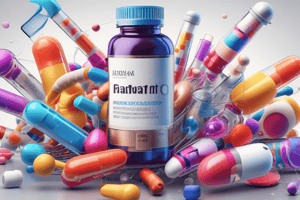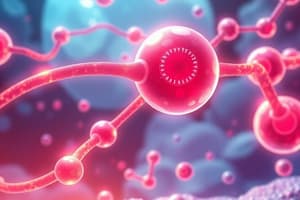Podcast
Questions and Answers
What is the study of drugs and their effects on living organisms called?
What is the study of drugs and their effects on living organisms called?
- Biochemistry
- Pharmacology (correct)
- Physiology
- Anatomy
Which of the following describes how drugs are processed by the body, including absorption, distribution, metabolism and excretion?
Which of the following describes how drugs are processed by the body, including absorption, distribution, metabolism and excretion?
- Pharmacodynamics
- Toxicology
- Pharmacokinetics (correct)
- Drug action
What type of drug blocks the action of natural regulatory molecules or other agonists?
What type of drug blocks the action of natural regulatory molecules or other agonists?
- Metabolite
- Agonist
- Catalyst
- Antagonist (correct)
Which process describes how drugs enter the bloodstream?
Which process describes how drugs enter the bloodstream?
What term describes the study of the relationship between drug concentration and its effects on the body?
What term describes the study of the relationship between drug concentration and its effects on the body?
What is the main advantage of intravenous drug administration?
What is the main advantage of intravenous drug administration?
Which factor is NOT typically considered when deciding on the route of drug administration?
Which factor is NOT typically considered when deciding on the route of drug administration?
What is an idiosyncratic drug reaction?
What is an idiosyncratic drug reaction?
Which of the following best describes a synergistic drug interaction?
Which of the following best describes a synergistic drug interaction?
Which of these is a key step in drug development process?
Which of these is a key step in drug development process?
Flashcards
Pharmacology
Pharmacology
The study of drugs and their effects on living organisms, including their discovery, development, mechanisms of action, pharmacokinetics, pharmacodynamics, and toxicology.
Drug Action
Drug Action
The change in the physiology of the body caused by a drug's interaction with specific molecular targets.
Pharmacokinetics
Pharmacokinetics
The study of how a drug moves through the body, including absorption, distribution, metabolism, and excretion.
Pharmacodynamics
Pharmacodynamics
Signup and view all the flashcards
Agonist
Agonist
Signup and view all the flashcards
Intravenous Administration
Intravenous Administration
Signup and view all the flashcards
Adverse Drug Reactions (ADRs)
Adverse Drug Reactions (ADRs)
Signup and view all the flashcards
Toxicity
Toxicity
Signup and view all the flashcards
Drug Design
Drug Design
Signup and view all the flashcards
Drug Interactions
Drug Interactions
Signup and view all the flashcards
Study Notes
Introduction to Pharmacology
- Pharmacology is the study of drugs and their effects on living organisms.
- It encompasses various aspects, including drug discovery, development, mechanisms of action, pharmacokinetics, pharmacodynamics, and toxicology.
- Drug action is the change in the physiology of the body brought about through interaction with a drug.
- Drugs interact with specific molecular targets within the body, thereby causing physiological effects.
- Drug targets include proteins such as enzymes, ion channels, receptors, and transport proteins.
Drug Actions and Targets
- Drug action is typically mediated through interaction with specific macromolecular targets (receptors).
- Binding of a drug to a target often results in a change in the target's shape and/or function.
- This alteration in the target leads to a cascade of events, producing a physiological response.
- Agonists are drugs that mimic the action of natural regulatory molecules.
- Antagonists are drugs that block the action of natural regulatory molecules or agonists.
- Drugs may have different affinities to the target molecule.
Pharmacokinetics
- Pharmacokinetics describes how the body processes drugs, including absorption, distribution, metabolism, and excretion.
- Absorption is the process by which a drug enters the bloodstream.
- Distribution is the process by which a drug travels through the body, reaching its target site.
- Metabolism is the process by which the body chemically changes a drug.
- Excretion is the removal of a drug from the body.
- Factors affecting pharmacokinetics include age, gender, genetics, and underlying medical conditions.
Pharmacodynamics
- Pharmacodynamics focuses on the relationship between drug concentration and its effects on the body.
- It investigates how drugs interact with their targets, the mechanisms behind their effects, and the intensity and duration of those effects.
- It also considers drug selectivity (how specific the drug is for different targets).
- The effectiveness and safety of a drug depend on its pharmacodynamics profile.
- Drug response can vary between individuals due to factors such as genetic variation, disease status, and environmental exposures.
Drug Administration Routes
- Different routes of drug administration have varying effects on absorption rates.
- Oral administration is common but can be slower and less predictable than other routes.
- Intravenous administration delivers drugs directly into the bloodstream, allowing for immediate effects.
- Other routes include intramuscular, subcutaneous, topical, and inhalational administrations.
- Factors like solubility, stability, and target tissue location must be considered when choosing a route.
Drug Safety and Toxicity
- Drug safety is a critical consideration throughout the development and use of drugs.
- Adverse drug reactions (ADRs) are unwanted effects of drugs.
- Toxicity is the degree to which a drug is harmful.
- Toxicity can arise from overdosing, idiosyncratic drug reactions (unexpected/unusual responses), or drug interactions.
- Careful monitoring and risk assessment are essential during preclinical and clinical trials and throughout drug use.
Drug Design and Development
- Drug design involves developing new chemical compounds that can interact with biological targets to produce therapeutic effects.
- Development involves preclinical testing, clinical trials, regulatory approval, and post-marketing surveillance.
- Drug development stages often include identifying drug targets, synthesizing and testing drug candidates, establishing safety and efficacy profiles, and obtaining regulatory approvals.
Drug Interactions
- Drug interactions occur when multiple drugs are administered concurrently.
- Interactions can be synergistic (drugs work together to achieve enhanced effects) or antagonistic (drugs interfere with each other's actions).
- Interactions can cause dangerous effects (sometimes even lethal ones) or they can produce beneficial outcomes.
- Drug interactions and potential side effects must be carefully evaluated and monitored.
Studying That Suits You
Use AI to generate personalized quizzes and flashcards to suit your learning preferences.




